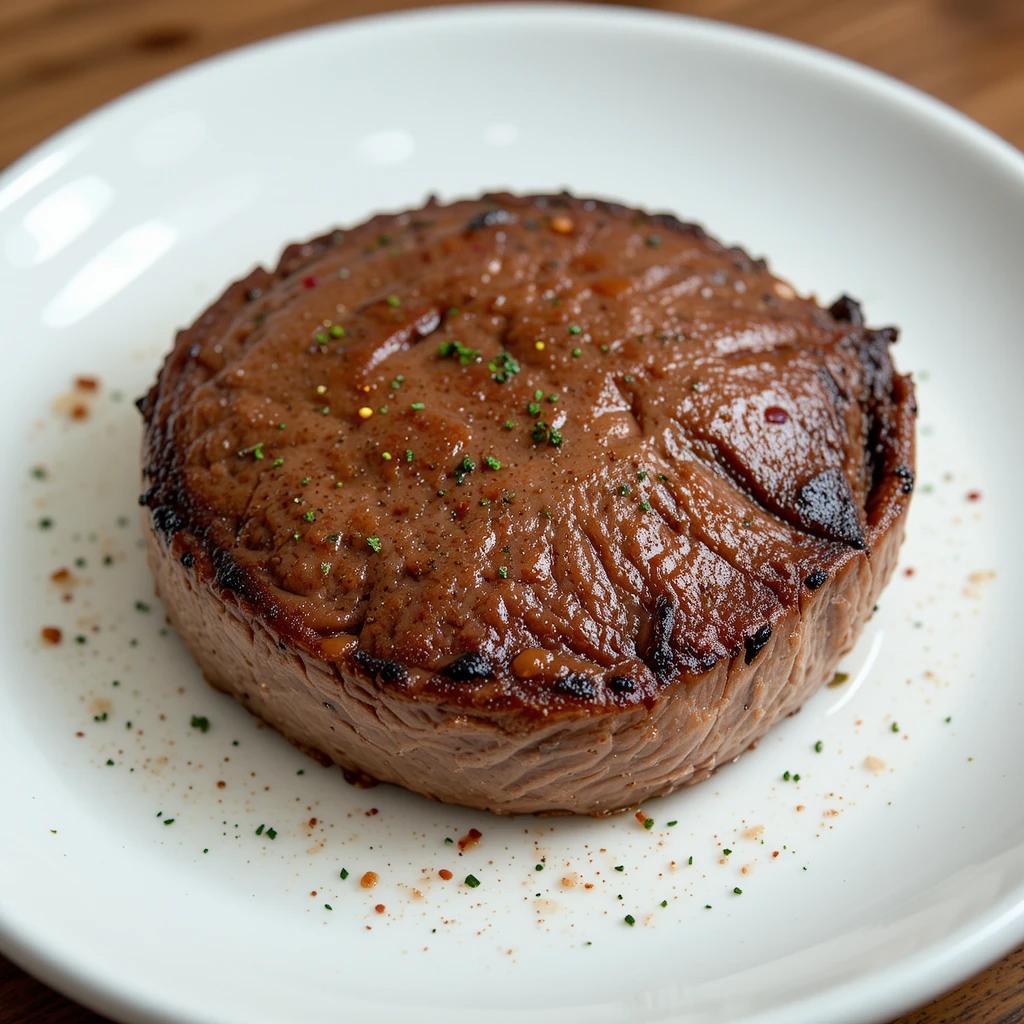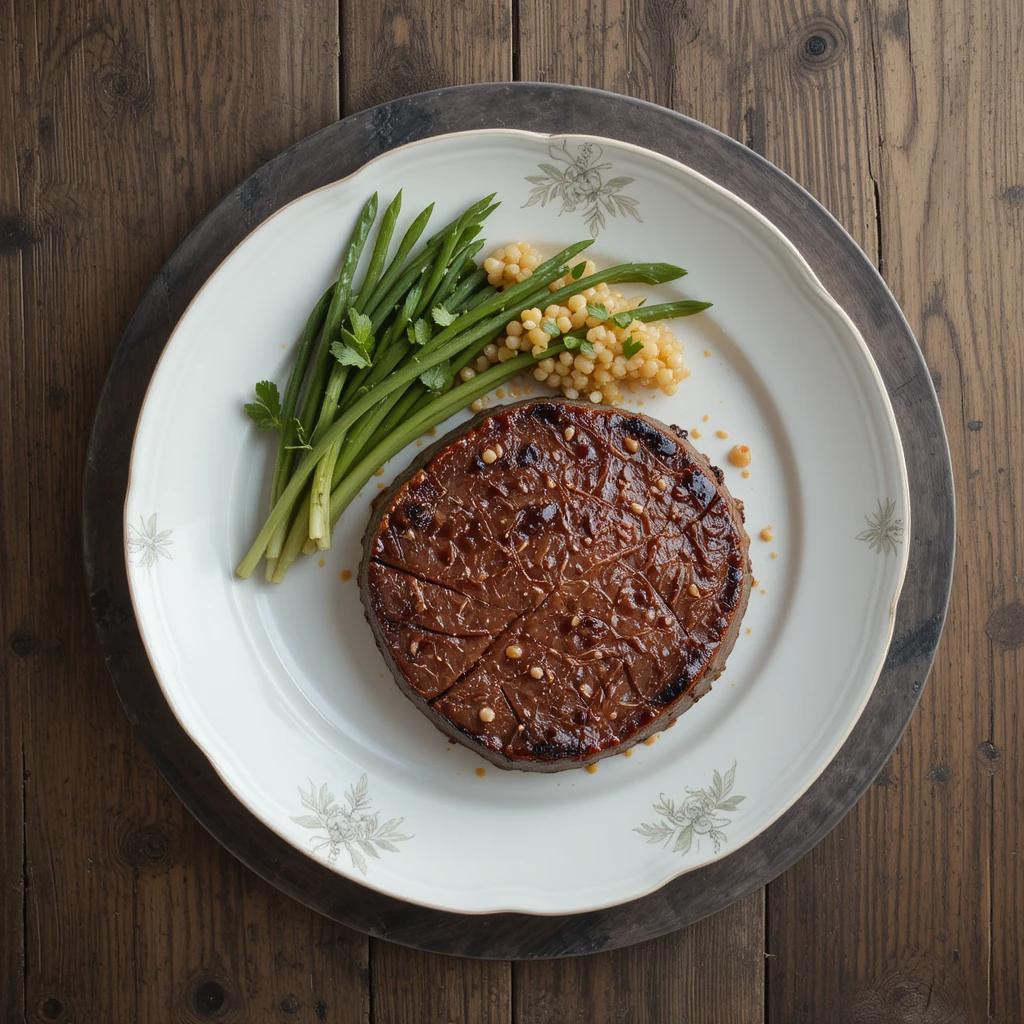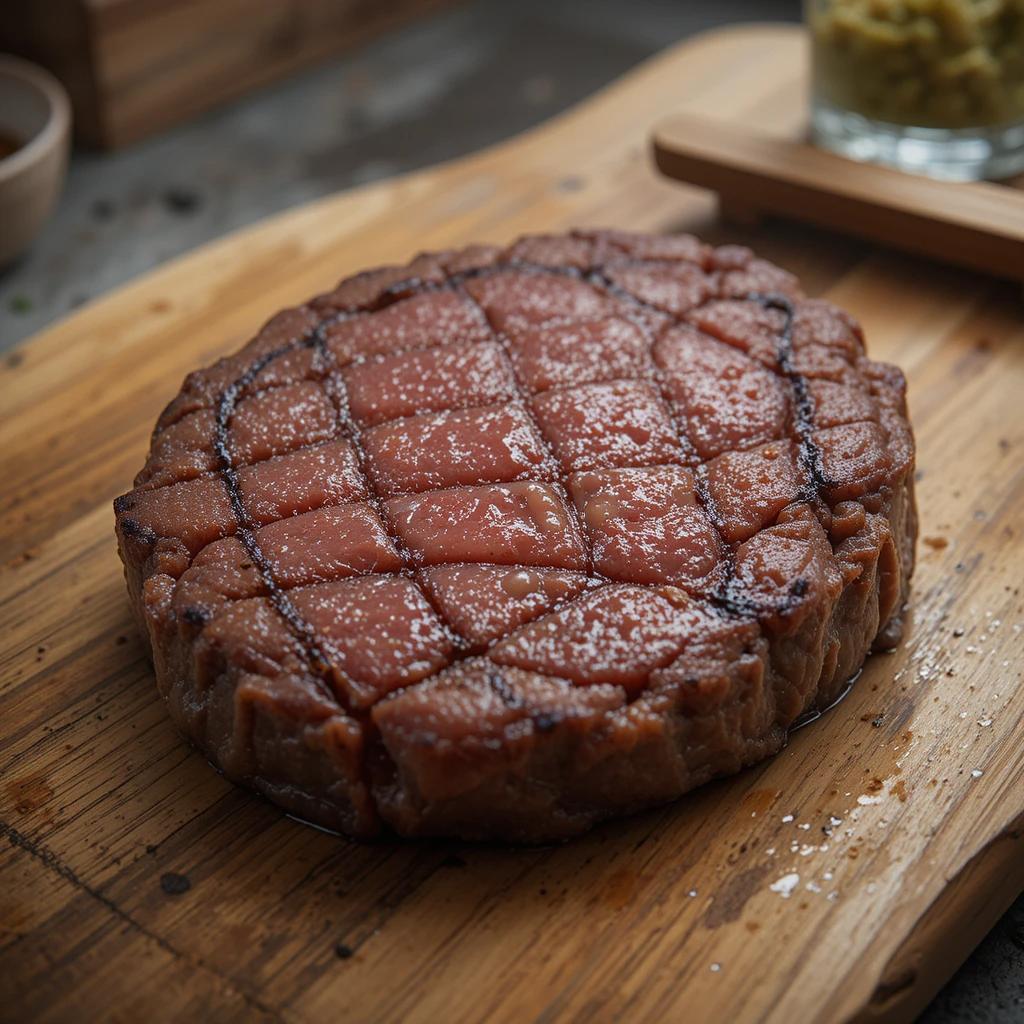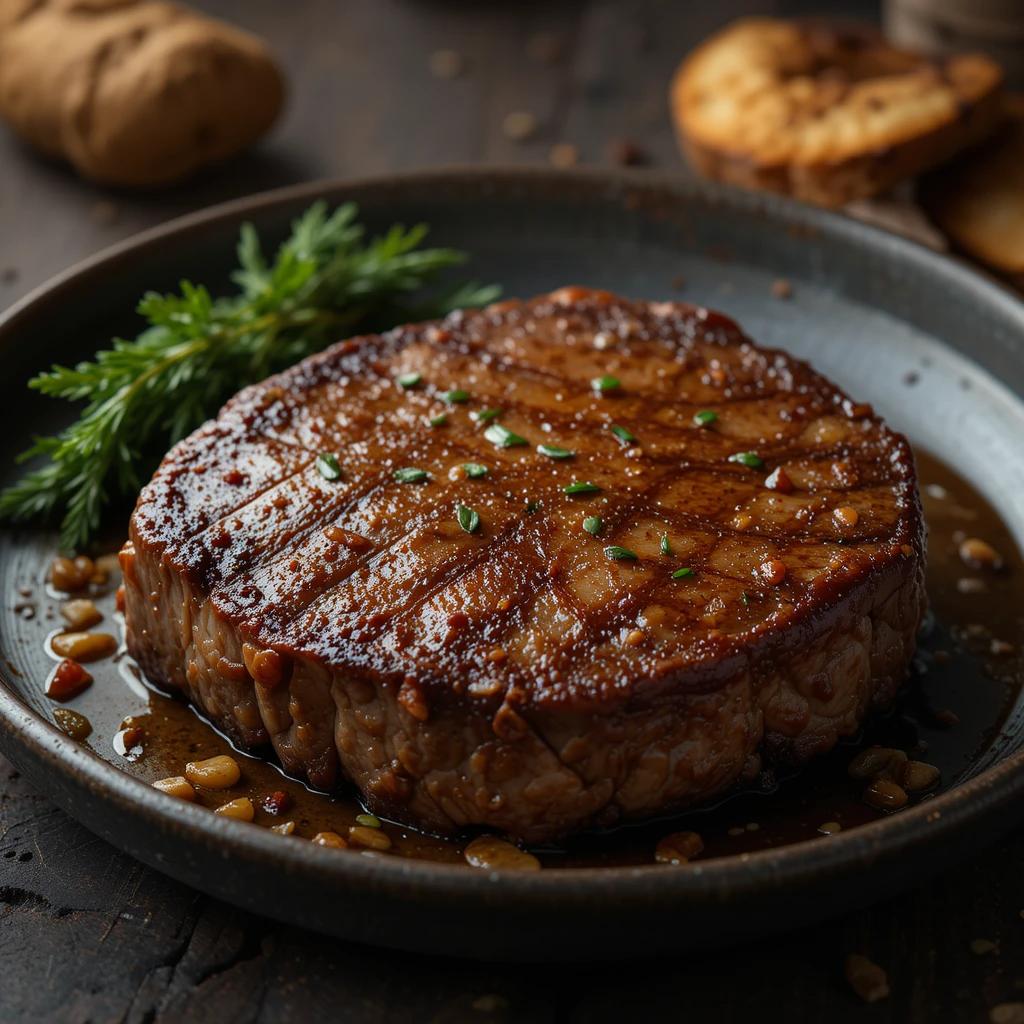Introduction to Beef Bottom Round Steak
Beef bottom round steak is a lean and versatile cut of beef sourced from the rear leg or “round” section of the cow. Known for its robust beef flavor and affordable price, this cut is a staple in many kitchens. While it is not as tender as premium cuts like ribeye or tenderloin, its lower fat content makes it a healthier choice, and proper cooking methods can unlock its full potential.
What is Beef Bottom Round Steak?
Beef bottom round steak is a boneless cut from the bottom portion of the round primal, located near the hindquarters of the cow. It is relatively lean with a firm texture, making it well-suited for various cooking methods such as braising, slow cooking, or marinating and grilling.
The steak is often sold as thin slices or in larger portions that can be cut into smaller steaks. It is commonly used in dishes such as stir-fries, stews, or roasts, where moist cooking methods tenderize the meat and enhance its flavor.
Why is Beef Bottom Round Steak Popular?
- Affordability
Bottom round steak is an economical choice compared to pricier cuts like ribeye or strip steak. Its cost-effectiveness makes it accessible to a wide range of consumers. - Versatility
This steak can be prepared in numerous ways, from marinated and grilled steaks to slow-cooked dishes like pot roast or shredded beef. Its adaptability makes it a favorite among home cooks. - Flavor
Despite being lean, bottom round steak has a deep, beefy flavor that stands out when seasoned and cooked properly. - Nutritional Benefits
With its low-fat content, bottom round steak is a healthier red meat option, appealing to health-conscious individuals.
Nutritional Value of Beef Bottom Round Steak
Beef bottom round steak is a nutrient-dense food, offering a good balance of protein, vitamins, and minerals with relatively low fat. Here’s a general breakdown of its nutritional value per 3-ounce (85-gram) cooked serving:
- Calories: 140-170
- Protein: 25-28 grams
Protein is essential for muscle growth, repair, and overall health. - Fat: 3-5 grams
A lean option, with minimal saturated fat content. - Cholesterol: Approximately 60-70 milligrams
Contributes to the daily intake but should be moderated in heart-healthy diets. - Iron: 2-3 milligrams
Supports oxygen transport in the blood and energy metabolism. - Zinc: 5-6 milligrams
Boosts immune function and supports cellular health. - B-Vitamins:
- Vitamin B12: Critical for nerve function and DNA synthesis.
- Niacin (B3): Supports energy production and cardiovascular health.
Tips for Cooking Beef Bottom Round Steak
Due to its lean nature, bottom round steak benefits from techniques that add moisture and tenderness:
- Marinate the steak to infuse flavor and improve texture.
- Use slow cooking methods like braising or stewing to break down connective tissues.
- Slice thinly against the grain after cooking to maximize tenderness.
Beef bottom round steak is a budget-friendly, flavorful, and nutritious addition to your meal rotation, making it an excellent choice for health-conscious individuals and those seeking versatility in the kitchen.
Understanding Bottom Round Steak

The Cut of Meat: Where It Comes From
Bottom round steak is cut from the round primal of the cow, which refers to the rear leg and hindquarters. Specifically, it comes from the bottom round sub-primal, a portion of the round primal located on the outer section of the leg. The muscles in this area are heavily used for movement, resulting in lean, firm meat with less intramuscular fat (marbling) than more tender cuts like ribeye or tenderloin.
Key details about its origin:
- Part of the round primal, which also includes top round, eye of round, and rump roast.
- The bottom round is the larger and more fibrous section compared to the top round or eye of round.
Characteristics of Bottom Round Steak
Bottom round steak has distinct characteristics that define its texture, flavor, and cooking methods:
- Leanness
This cut is very low in fat, making it a healthier option compared to fattier cuts. However, its lack of marbling also means it can be less tender. - Texture
The meat is dense and slightly coarse, with strong muscle fibers that can become tough if not cooked properly. - Flavor
Bottom round steak has a robust beefy flavor that shines when paired with seasonings or sauces. It works well in dishes where the meat absorbs other flavors. - Appearance
Typically sold as thin slices or steak-like cuts, the meat has a deep red color, which reflects its leanness. - Cooking Suitability
Best suited for moist-heat cooking methods (braising, slow-cooking) to break down its muscle fibers. When prepared with care, it can also be grilled or pan-seared if tenderized and marinated beforehand.
How Bottom Round Steak Differs from Other Cuts
1. Comparison with Top Round Steak
- Location: Both cuts come from the round primal, but top round is situated above the bottom round and is slightly more tender.
- Texture: Top round has finer muscle fibers, making it better suited for roasting and slicing.
- Cooking Methods: While bottom round is more ideal for slow cooking, top round is preferred for oven roasting or as deli-style roast beef.
2. Comparison with Ribeye
- Marbling: Ribeye is heavily marbled with fat, contributing to its tenderness and juiciness, while bottom round steak is lean with little fat.
- Flavor: Ribeye has a rich, buttery flavor, whereas bottom round steak offers a more straightforward beef taste.
- Cooking: Ribeye is best suited for grilling or pan-searing, while bottom round requires methods to enhance tenderness.
3. Comparison with Tenderloin
- Tenderness: Tenderloin (or filet mignon) is among the most tender cuts of beef due to its minimal muscle use, whereas bottom round is tougher and chewier.
- Cooking: Tenderloin cooks quickly over high heat, while bottom round benefits from low-and-slow techniques.
4. Comparison with Chuck Steak
- Location: Chuck comes from the shoulder section of the cow, whereas bottom round is from the hindquarters.
- Texture: Chuck has more connective tissue and fat, making it ideal for braising, while bottom round is leaner and less forgiving when overcooked.
Summary of Key Differences
| Cut | Location | Fat Content | Tenderness | Cooking Methods |
|---|---|---|---|---|
| Bottom Round | Rear leg/hindquarters | Very low | Firm, slightly coarse | Slow-cooking, braising |
| Top Round | Above the bottom round | Low | Slightly tender | Roasting, slow-cooking |
| Ribeye | Rib section | High | Very tender | Grilling, pan-searing |
| Tenderloin | Loin (back) | Very low | Extremely tender | Quick, high-heat cooking |
| Chuck | Shoulder | Moderate to high | Tender when slow-cooked | Braising, stewing |
Understanding these differences ensures you can choose the right cut for your dish and cooking method. Bottom round steak’s affordability and versatility make it a valuable addition to any meat selection.
Buying Bottom Round Steak
How to Choose the Perfect Cut
- Appearance: Look for a vibrant red color, indicating freshness. The meat should have minimal brown or gray discoloration.
- Fat Content: A bottom round steak will have little visible fat. Small traces of external fat or marbling are acceptable and can enhance flavor.
- Cut Thickness: Opt for evenly cut steaks to ensure uniform cooking.
What to Look for in Quality
- Firm Texture: Press the meat gently; it should feel firm but not hard.
- Moisture: The steak should be slightly moist but not slimy or overly wet.
- Smell: A fresh steak should have little to no odor. Avoid cuts with a sour or off-putting smell.
Organic vs. Conventional Beef
- Organic Beef: Raised without synthetic hormones, antibiotics, or genetically modified feed. It is often more expensive but may appeal to those seeking environmentally friendly or health-conscious options.
- Conventional Beef: Generally less expensive and widely available. If choosing conventional beef, look for USDA Choice or Prime grades for better quality.
Preparing Bottom Round Steak
Properly Thawing Steak
- Refrigerator Method: Place the steak in its packaging on a plate and thaw in the fridge for 24 hours. This is the safest method.
- Cold Water Method: Submerge the steak (sealed in a plastic bag) in cold water. Change the water every 30 minutes until thawed.
- Avoid: Do not thaw at room temperature to prevent bacterial growth.
Trimming and Tenderizing Techniques
- Trimming: Remove any excess surface fat or silver skin (a thin, tough connective tissue) using a sharp knife.
- Tenderizing:
- Use a meat mallet to pound the steak lightly, breaking down tough muscle fibers.
- Alternatively, score the surface with a knife in a crisscross pattern.
Marinating for Flavor and Texture
- Combine acidic ingredients (e.g., vinegar, lemon juice, or wine) with oil, spices, and herbs to create a marinade.
- Place the steak in a resealable bag with the marinade and refrigerate for at least 2 hours or overnight for best results.
Cooking Methods for Bottom Round Steak

Overview of Cooking Methods
- Pan-Searing: Quick cooking over high heat to develop a crust.
- Slow Cooking: Ideal for tenderizing the meat with long, moist heat.
- Grilling: Adds smoky flavor and charred texture.
- Sous Vide: A precise, low-temperature method for even cooking.
Pan-Seared Bottom Round Steak Recipe
Ingredients List
- 2 bottom round steaks (about 1-inch thick)
- 2 tablespoons olive oil
- 1 teaspoon salt
- ½ teaspoon black pepper
- 1 teaspoon garlic powder
- Fresh thyme (optional)
Step-by-Step Cooking Process
- Season the Steak: Pat steaks dry and season both sides with salt, pepper, and garlic powder.
- Preheat the Pan: Heat olive oil in a skillet over medium-high heat until it shimmers.
- Sear the Steak: Place the steak in the hot pan and sear for 3-4 minutes per side.
- Check Doneness: Use a meat thermometer to ensure an internal temperature of 130°F (medium-rare) or adjust for preference.
- Rest and Serve: Remove the steak from the pan, tent with foil, and rest for 5 minutes before serving.
Tips for a Perfect Sear
- Use a cast-iron skillet for even heat distribution.
- Avoid overcrowding the pan; cook steaks in batches if necessary.
Slow-Cooked Bottom Round Steak Recipe
Ingredients and Preparation
- 2-3 bottom round steaks
- 1 cup beef broth
- 1 cup diced onions
- 2 garlic cloves, minced
- 1 teaspoon dried thyme
- 2 tablespoons Worcestershire sauce
- Salt and pepper to taste
Cooking Time and Techniques
- Prepare Ingredients: Season steaks with salt and pepper. Sauté onions and garlic in a skillet.
- Assemble in Slow Cooker: Place steaks in a slow cooker. Add sautéed onions, garlic, beef broth, Worcestershire sauce, and thyme.
- Cook: Cover and cook on low for 6-8 hours or on high for 4-5 hours, until tender.
Serving Suggestions
- Serve with mashed potatoes, rice, or roasted vegetables.
- Use the cooking liquid as a gravy by reducing it in a saucepan.
Grilled Bottom Round Steak Recipe
Preparing the Grill
- Preheat the grill to medium-high heat (around 400°F).
- Clean and oil the grates to prevent sticking.
Recipe Steps for Grilling
- Marinate the Steak: Use your preferred marinade for at least 2 hours.
- Grill: Place the steak on the grill and cook for 4-5 minutes per side for medium-rare. Use a thermometer for precision.
- Rest: Let the steak rest for 5-7 minutes before slicing.
Achieving the Right Doneness
- Medium-Rare: 130°F
- Medium: 140°F
- Medium-Well: 150°F
Sous Vide Bottom Round Steak Recipe
What is Sous Vide?
Sous vide is a cooking method where food is vacuum-sealed and cooked in a water bath at a precisely controlled temperature. This technique ensures even cooking and tenderness.
Why It Works for This Cut
- Tenderizes the naturally tough bottom round steak by breaking down muscle fibers slowly.
- Retains juices and enhances flavor.
Recipe Instructions
- Ingredients:
- 2 bottom round steaks
- 2 tablespoons olive oil
- Salt, pepper, and garlic powder
- Fresh rosemary (optional)
- Set Up Sous Vide:
- Preheat the sous vide water bath to 131°F (medium-rare).
- Prepare the Steak:
- Season the steak with salt, pepper, and garlic powder. Seal it in a vacuum bag with a drizzle of olive oil and a sprig of rosemary.
- Cook:
- Submerge the bag in the water bath and cook for 6-8 hours.
- Sear the Steak:
- After sous vide cooking, heat a skillet with a small amount of oil. Sear the steak on both sides for 1-2 minutes to develop a crust.
- Serve:
- Slice thinly against the grain and enjoy.
With these recipes and methods, you can maximize the flavor and tenderness of bottom round steak while adapting it to your preferred cooking style.
Storing and Reheating Leftovers

Tips for Proper Storage
- Cool Quickly: Allow the steak to cool to room temperature before storing, but do not leave it out for more than 2 hours to avoid bacterial growth.
- Use Airtight Containers: Store leftover steak in airtight containers or wrap it tightly in aluminum foil or plastic wrap to prevent drying out.
- Label and Date: Clearly label and date the storage containers to track freshness.
- Refrigeration: Store in the refrigerator for up to 3-4 days.
- Freezing: For longer storage, freeze steak in heavy-duty freezer bags or vacuum-sealed packaging. It can last up to 3 months in the freezer without significant loss of quality.
Reheating Techniques to Preserve Flavor
- Oven Reheating:
- Preheat the oven to 250°F.
- Place the steak on a wire rack set over a baking sheet to allow even heat circulation.
- Warm for 20-30 minutes until the internal temperature reaches around 130°F (for medium-rare).
- Skillet Reheating:
- Heat a small amount of oil or butter in a skillet over low to medium heat.
- Add the steak and gently heat, flipping occasionally, until warmed through.
- Sous Vide Method:
- Place the steak in a vacuum-sealed bag or freezer bag.
- Reheat in a sous vide water bath set to 130°F (for medium-rare) for about 30-40 minutes.
- Microwave Reheating (Last Resort):
- Use a microwave-safe dish and cover the steak with a damp paper towel.
- Heat in short bursts (20-30 seconds) to avoid overcooking and drying.
Avoiding Common Mistakes
- Overheating: High heat can make the steak tough and dry. Use gentle heating methods to preserve moisture.
- Skipping Resting Time: After reheating, let the steak rest for a few minutes to redistribute juices.
- Reheating Multiple Times: Reheat only the portion you plan to eat to maintain flavor and texture.
Health Benefits of Bottom Round Steak
Protein Content and Muscle-Building Benefits
- High Protein: Bottom round steak provides approximately 25-28 grams of protein per 3-ounce serving, making it excellent for muscle repair and growth.
- Lean Meat: Its low-fat content makes it suitable for those looking to build muscle while maintaining a lean physique.
Vitamins and Minerals
- Iron:
- Supports oxygen transportation in the blood and prevents anemia.
- One serving provides about 10-15% of the daily recommended intake.
- Zinc:
- Boosts immune function and aids in cellular repair.
- Bottom round steak is a rich source of zinc, with 30-40% of the daily requirement per serving.
- B-Vitamins:
- Vitamin B12: Crucial for nerve health and DNA synthesis.
- Niacin (B3): Promotes cardiovascular health and energy production.
- Vitamin B6: Supports brain health and red blood cell production.
Comparing Nutritional Value with Other Cuts
- Ribeye: Higher in fat and calories due to its marbling, but also more flavorful.
- Tenderloin: Lean like bottom round steak but more tender and less flavorful.
- Chuck Roast: Higher in connective tissue and fat, making it richer in flavor but less lean.
- Top Round: Similar in leanness but slightly more tender and easier to cook.
Bottom round steak stands out as a lean, nutrient-dense, and economical choice for health-conscious individuals.
Common Mistakes to Avoid
Overcooking and Toughness
- Bottom round steak is lean with minimal fat, so overcooking can result in dryness and a tough texture.
- Use a meat thermometer to monitor doneness and aim for medium-rare (130-135°F) for optimal tenderness.
- Cook low and slow when braising or slow cooking to break down muscle fibers.
Inadequate Seasoning
- Lean cuts like bottom round steak rely on seasoning or marinades to enhance their flavor.
- Avoid skipping seasoning steps, even for simple preparations, to ensure a well-rounded taste.
- Incorporate salt, pepper, garlic, or acidic ingredients (e.g., lemon or vinegar) to balance the meat’s natural beefy flavor.
Not Resting the Meat
- Failing to rest the steak after cooking or reheating can cause juices to escape when sliced, resulting in a dry and less flavorful steak.
- Let the steak rest for at least 5-10 minutes before cutting to allow the juices to redistribute.
By following these tips and avoiding common mistakes, you can fully enjoy the flavor, texture, and nutritional benefits of bottom round steak while making the most of your meals.
FAQs About Bottom Round Steak
1. What Are the Best Cooking Methods?
- Slow Cooking: Perfect for tenderizing the naturally tough cut. Use braising, pot roasting, or stewing for best results.
- Sous Vide: Delivers consistent results by breaking down fibers gently while retaining moisture.
- Pan-Searing: Great for a quick meal when paired with a marinade or tenderizing techniques.
- Grilling: Achievable with proper marination and slicing thinly against the grain after cooking.
2. Is Bottom Round Steak Tender?
- By nature, it is not as tender as cuts like tenderloin or ribeye due to its lean, muscular composition.
- However, with proper preparation, such as marinating, tenderizing, or slow cooking, it can become quite tender and flavorful.
3. What’s the Difference Between Bottom Round and Top Round?
- Location: Both come from the round primal, but top round is cut from the upper portion, while bottom round is from the lower section.
- Tenderness: Top round is slightly more tender than bottom round, making it better suited for roasting or slicing.
- Cooking Methods: Bottom round benefits from moist-heat cooking, while top round is versatile enough for roasting or pan-frying.
- Flavor: Both have robust beefy flavors, but bottom round is often perceived as more fibrous due to its tougher muscle fibers.
Conclusion
Recap of Key Points
- Bottom round steak is a lean, economical cut that offers robust beef flavor and excellent versatility.
- It shines in dishes that utilize slow cooking, sous vide, or marination to enhance its tenderness and flavor.
- Nutritionally, it’s a great source of high-quality protein, iron, and B-vitamins while being low in fat.
- Proper preparation techniques, such as marinating and slicing against the grain, can elevate its texture and taste.
Encouragement to Try the Recipes
With a variety of recipes available, from pan-searing to slow-cooking, there’s no shortage of delicious ways to enjoy bottom round steak. Each method highlights different aspects of the cut, providing a flavorful and satisfying experience.
Tips for Further Experimentation
- Experiment with Marinades: Use different combinations of herbs, spices, and acids to discover your favorite flavor profile.
- Explore Global Cuisines: Incorporate bottom round steak into dishes like stir-fries, curries, or fajitas.
- Cooking Tools: Try advanced techniques like sous vide or use a slow cooker for convenience and optimal results.
Bottom round steak may require a bit of care and attention, but it rewards you with rich flavors and versatility. By following these tips and experimenting with different methods, you can turn this affordable cut into a centerpiece for memorable meals.
Round Steak and Gravy
Smothered Round Steak with Gravy
Related Recipes
- “Tuna Tomato Sauce Pasta Recipe“: A tomato-based recipe showcasing another way to use tomatoes.
- “Baked Chicken Fettuccine Alfredo with Broccoli“: Another comforting dish that can be complemented with tomato-based sauces.
Ingredient-Focused Content
- “Lions Mane Mushroom Recipe“: Suggest using a tomato gravy as a flavorful addition for plant-based dishes.
Cooking Techniques and Enhancements
- “Mango Habanero Salsa“: Explore complementary uses of sauces and gravies for flavor diversity.
Storage and Reuse Tips
- “Sous Vide Recipes“: Recommend tomato gravy as a sauce for sous vide-cooked meats or vegetables.
- “Ocean Spray Cranberry Sauce Recipe“: Guide readers on making and storing sauces, including tomato gravy.

